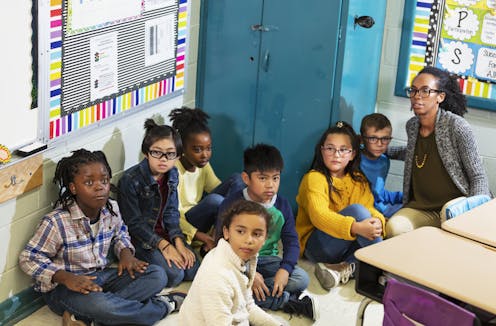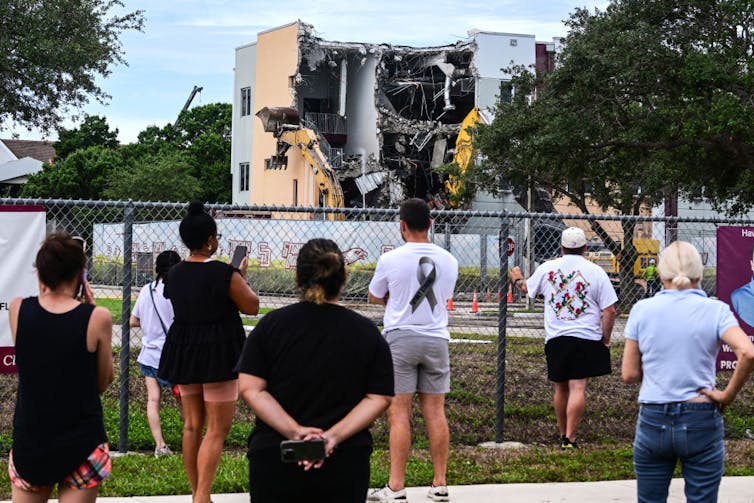Today’s school children practice running for their lives – but there are better ways to keep student
The persistent threat of school shootings demands a more thoughtful response to their prevention.

A 6-year-old girl lost one of her white Adidas lace-up sneakers as she and her 21 classmates practiced fleeing for their lives after an imaginary intruder entered their school.
The girl’s teacher told her to keep moving without her shoe, then grabbed it herself and gave it back to the girl when the class settled into their designated safe location.
The girl recently recounted the story of losing her shoe during a morning car ride to school. It was just one of several times the girl or her siblings described what they were supposed to do – run “over to that fence,” “across that field” or “into those woods” – if an intruder enters their school building.
The reason I know this story is because the girl is my daughter.
In the quarter-century since the Columbine High School massacre of April 20, 1999, a whole generation of children, including my own, have lived under the threat of school-related gun violence. More recent tragedies, like those occurring at Sandy Hook Elementary School in Connecticut in December 2012 and Robb Elementary School in Texas in May 2022, reveal the persistent nature of this threat.
Regrettably, gun violence stands at the backdrop of all contemporary American education. As such, active shooter and intruder drills have become standard fare, not only for my children but for nearly all American schoolchildren.
I am concerned about the fact that preparedness exercises – such as the one in which my daughter temporarily lost her shoe – sometimes cause students harm. For example, a recent study showed that active intruder drills can result in distress and anxiety for students. In another case, one of these drills led to hysteria and a stampede in a school in Florida as students attempted to flee their faux intruder. Students and teachers alike experienced terror at the pronouncement of a real threat, that it was “not a drill.”
As a researcher in developmental and educational psychology – and as a faculty member who trains future teachers – I understand the need for schools to ensure the safety and security of the nation’s 55 million school-age youth. But might there be a better way to protect children in the post-Columbine era?
I’m not the only one raising this question. A new initiative by the National Academies has been initiated to assess the effects of active shooter drills on student health and well-being and to determine best practices in preparing schools to respond to threats of violence.
A look at the trends
To gain insight on the prevalence of school-related gun violence, my colleagues and I conducted a study of school shootings and school mass shootings that took place in America’s K-12 schools from 1997 through 2022. We used two public databases to count school shootings and school mass shootings that occurred each school year.
School shootings in our study were defined as “each and every instance a gun is brandished, is fired, or a bullet hits school property for any reason, regardless of the number of victims, time of day, or day of week.” School mass shootings were defined as those that happened at a K-12 school site and met the federal definition of a mass shooting in place at the time of the shooting: four or more victims killed, up to December 2012, or three or more victims killed, from January 2013 onward.
During the 25 school years we examined, 1997-2022, there were 1,453 school shootings. More than half of those, 794, occurred in the last five years, 2017-2022. Our analyses revealed a sharp increase in school shootings after 2017, with the number of shootings jumping from a then-record high of 89 in the 2017-2018 school year to 328 in the 2021-2022 school year.
While the number of school shootings has increased dramatically in recent years, the number of school mass shootings has not increased at the same rate – though they have become more deadly. In total, 11 school mass shootings occurred across the 1997-1998 to 2021-2022 school years, with 126 fatalities and 122 injuries sustained overall. Five of those school mass shootings occurred in the 1997-2012 school years, while six occurred in the 2012-2022 school years. Nevertheless, the fatality rate nearly doubled in the last decade, rising from 7.6 deaths per mass shooting event from 1997-2012 to 14 deaths per school mass shooting event from 2012-2022.
Efforts to maximize student safety are paramount. To be sure, I want my children’s schools to do their utmost to protect their students. However, many current measures designed to keep students safe – like the appointment of school resource officers – have not been proven to prevent school shootings or lessen the severity of school shootings, in terms of injury or fatality, when they do occur.
Gun injury is now the leading cause of death for children and adolescents in the United States. While school shootings and school mass shootings represent only a portion of gun injuries sustained by school-age youth, gun violence – including school-related gun violence – is a public health crisis. As such, a public health approach is merited.
Relying on research
I see at least three ways that schools and communities can work to lessen gun violence occurring in and around schools:
1: Educate parents and families about safe gun storage.
Educators and community health care providers – including pediatricians, primary care physicians and mental health clinicians – can engage in efforts to counsel families on safe firearm storage. Health care providers can also work to understand Extreme Risk Protection Order laws in their states; such laws allow them to coordinate with law enforcement to remove firearms from a home environment when an individual is identified who may be at risk of doing harm to self or others.
2: Utilize evidence-based, schoolwide approaches to promote school safety.
School safety can be supported through evidence-based frameworks, such as Positive Behavioral Interventions and Supports, which aims to improve school-based practices affecting student outcomes. This positive approach can be used to proactively address students’ social, emotional and behavioral needs and promote school safety. This approach also allows school personnel to monitor and manage students’ mental health needs, attend to schoolwide behavior and discipline issues, and foster a safe school climate. Accordingly, it may help reduce potential threats of gun violence perpetrated by students.
3: Support legislation and regulations for gun safety and violence prevention.
Community members, including parents and teachers, and policymakers can support legislation for gun safety, evidence-based violence prevention practices and regulations. For example, child access protection laws – laws that impose penalties on gun owners if children access firearms – decrease firearm injuries and gun carrying, and thus help promote safety in and around schools.

Hope for the future
The National Institute for Justice has made it a priority to support new research to study firearm violence and mass shootings, including research on the effectiveness of school campaigns to educate families on safe gun storage.
These efforts will provide important new insights about how to prevent school-related gun violence.
While my own children and their millions of peers attending school in the United States today continue to endure the threat of school-related gun violence, I hope future generations will experience school without having to worry about someone showing up at their school with a gun.
Luke J. Rapa does not work for, consult, own shares in or receive funding from any company or organization that would benefit from this article, and has disclosed no relevant affiliations beyond their academic appointment.
Read These Next
The ‘one chatbot per child’ model for AI in classrooms conflicts with what research shows: Learning
AI tutors are often held up as an ideal, but prioritizing individualized teaching can detract from the…
Getting peace right: Why justice needs to be baked into ceasefire agreements – including Ukraine’s
Just war theory, a centuries-old field of ethics, deals with how and when to start conflicts. It can…
How the NIH became the backbone of American medical research and a major driver of innovation and ec
The agency’s budget has grown steadily since the 1960s, fueling an industry that creates lifesaving…






